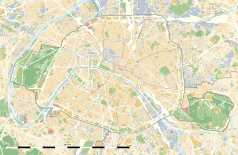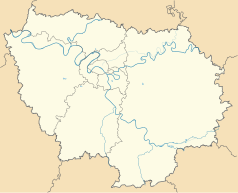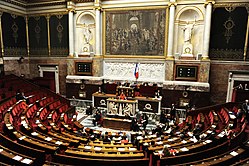Palais Bourbon
| ||
(c) Daniel Vorndran / DXR, CC BY-SA 3.0 Północna fasada pałacu | ||
| Państwo | ||
| Region | ||
| Miejscowość | Paryż | |
| Adres | 126 Rue de l'Université | |
| Styl architektoniczny | empire (klasycyzm) | |
| Rozpoczęcie budowy | 1722 | |
| Ukończenie budowy | 1728 | |
Plan budynku | ||
Położenie na mapie Paryża (c) Eric Gaba, Wikimedia Commons user Sting, CC BY-SA 3.0 | ||
| Strona internetowa | ||
Palais Bourbon – XVIII-wieczny pałac w Paryżu, siedziba francuskiego Zgromadzenia Narodowego[1]. Budynek położony jest w 7. dzielnicy, na południowym brzegu Sekwany, naprzeciw mostu Pont de la Concorde[2].
Historia
Pałac zbudowano w latach 1722–1728 dla Ludwiki Franciszki, księżnej Bourbon, córki króla Ludwika XIV. Projektem kierowało kolejno czterech architektów – Giardini, Pierre Cailleteau (Lassurance), Jacques Gabriel i Jean Aubert. Po śmierci księżnej w 1743 roku posiadłość nabył Ludwik XV, który z kolei odsprzedał ją w 1764 roku Ludwikowi Józefowi, księciu Condé. W 1791 roku, podczas rewolucji francuskiej pałac podległ konfiskacie i ogłoszony został mianem „dobra narodowego”. W 1795 roku przekazany został Radzie Pięciuset, która obradowała tu po raz pierwszy w 1798 roku, po przebudowie, za którą odpowiedzialni byli architekci Jacques-Pierre Gisors i Étienne-Chérubin Leconte. Północna fasada pałacu, portyk z dwunastoma kolumnami korynckimi, zbudowana została w 1806 roku według projektu Bernarda Poyeta. Po restauracji monarchii w 1814 roku książę Condé podjął działania na rzecz odzyskania posiadłości, zobowiązany został jednak do jej wynajmu Izbie Deputowanych. Ostatecznie w 1827 roku państwo francuskie stało się właścicielem pałacu. Obecny układ wnętrz zasadniczo pochodzi z lat 1827–1832, kiedy to jego przebudowy podjął się Jules de Joly. Do dekoracji wnętrz zaangażowany został malarz Eugène Delacroix[3].
Pałac wykorzystywany był jako miejsce obrad kolejnych organów ustawodawczych Francji – w tym Izby Deputowanych (Chambre des députés, 1814–1848), Ciała Prawodawczego (Corps législatif, 1852–1870), Izby Deputowanych (1879–1940) i Zgromadzenia Narodowego (Assemblée nationale, od 1946)[1][3].
Poza posiedzeniami parlamentarnymi pałac otwarty jest dla zwiedzających[2].
Przypisy
- ↑ a b palais Bourbon (fr.). Encyclopédie Larousse en ligne. [dostęp 2020-11-28].
- ↑ a b Assemblée Nationale - Palais Bourbon (ang.). Paris Convention and Visitors Bureau. [dostęp 2020-11-28].
- ↑ a b Histoire du Palais Bourbon et de l'hôtel de Lassay (fr.). Assemblée nationale. [dostęp 2020-11-28].
Media użyte na tej stronie
(c) Eric Gaba, Wikimedia Commons user Sting, CC BY-SA 3.0
Blank land cover map of the city and department of Paris, France, as in January 2012, for geo-location purpose, with distinct boundaries for departments and arrondissements.
Autor: Superbenjamin, Licencja: CC BY-SA 4.0
Blank administrative map of France for geo-location purpose, with regions and departements distinguished. Approximate scale : 1:3,000,000
Autor: Thibault Pelloquin, Licencja: CC BY-SA 3.0
Cette carte représente l'Île de France (en jaune pâle), ses limites départementales et régionales (en traits gris) et ses principaux cours et points d'eau (en bleu). Les départements limitrophes (sont en rose-orange pâle)
Autor: Patricia.fidi, Licencja: CC0
Unofficial (de facto) flag of the region Île-de-France in France. It was also the flag of the kingdom of France (s.XIV-XV)
Autor: Orionx, Licencja: CC BY-SA 3.0
Assemblée Nationale
Autor:
Ministère français de l'Enseignement supérieur et de la recherche
https://www.flickr.com/photos/ministere-enseignementsup-recherche/, Licencja: CC BY-SA 2.0Genevièvre Fioraso presente le projet de loi relatif a l'enseignement supérieur et à la recherche à l'Assemblée Nationale
Autor: Paris 16, Licencja: CC BY-SA 3.0
Plan of the Palais Bourbon, Paris.
- 1. Salon du public
- 2. Rotonde d'Alechinsky
- 3. Galerie des Fêtes
- 4. Galerie des Tapisseries
- 5. Salon du départ
- 6. Salle des Pas Perdus
- 7. Salle des Quatre Colonnes
- 8. Salon Delacroix
- 9. Salon Casimir-Perier
- 10. Salon Pujol
- 11. Salon Mazeppa
- 12. Salle des Conférences
- 13. Salle des séances or Hémicycle
- 14. Bibliothèque
- 15. Salle Colbert
- 16. Cour d'Honneur
- 17. Jardin des Quatre Colonnes
- 18. Jardin de la Présidence
Plate 11. The Hôtel de Lassay in Paris: elevation of the river facade. From Architecture françoise, Tome 1, Livre 2, Chapitre 23 (following p. 272 of the 1904 reimpression). For Blondel's discussion of this plate (in French), see p. 272 of tome 1 (at Gallica).
Autor: Moonik, Licencja: CC BY-SA 3.0
This building is classé au titre des monuments historiques de la France. It is indexed in the base Mérimée, a database of architectural heritage maintained by the French Ministry of Culture, under the reference PA00088698
(c) Daniel Vorndran / DXR, CC BY-SA 3.0
The Palais Bourbon, currently used as the seat of the Assemblée Nationale, the French lower house


















